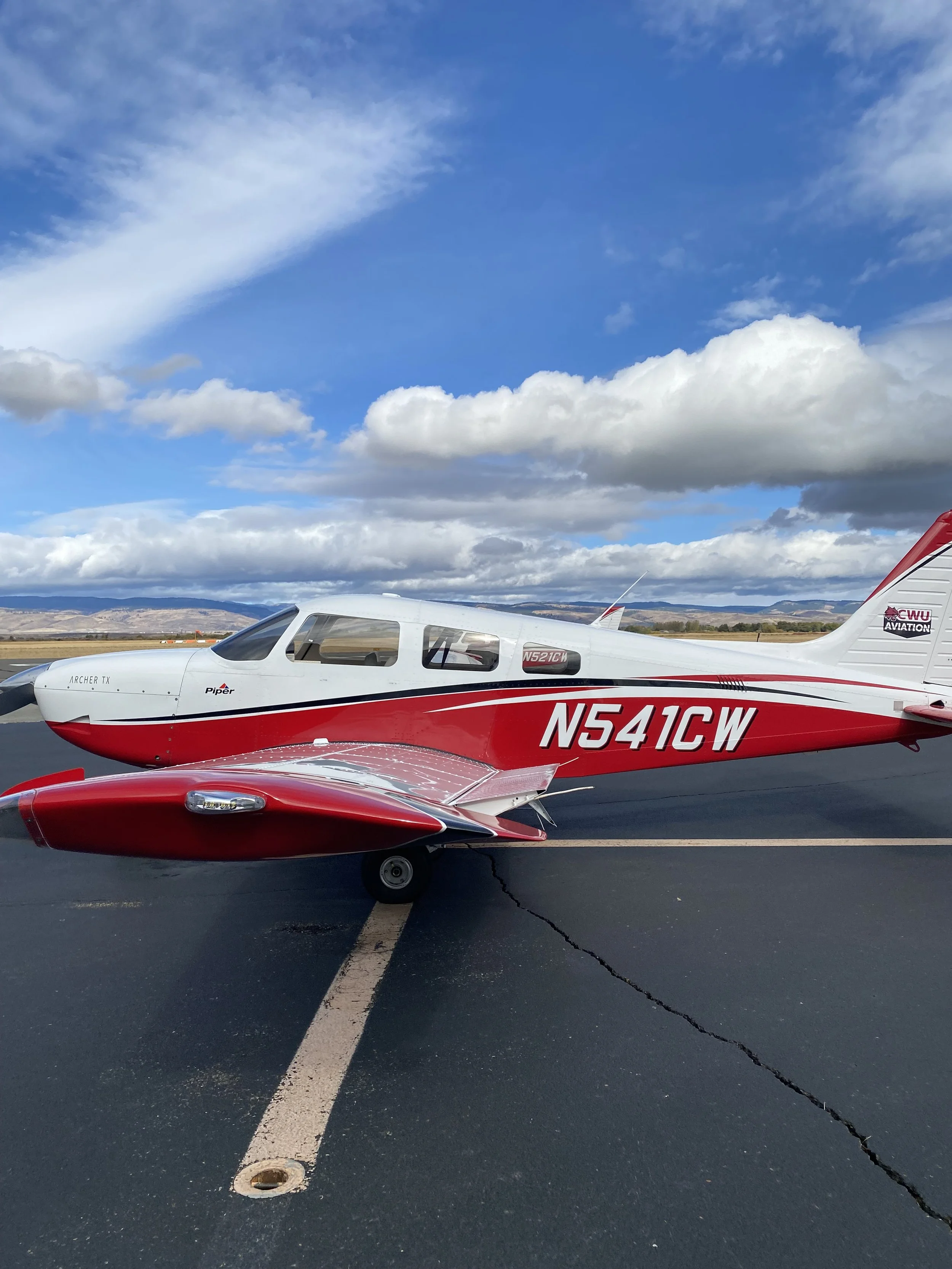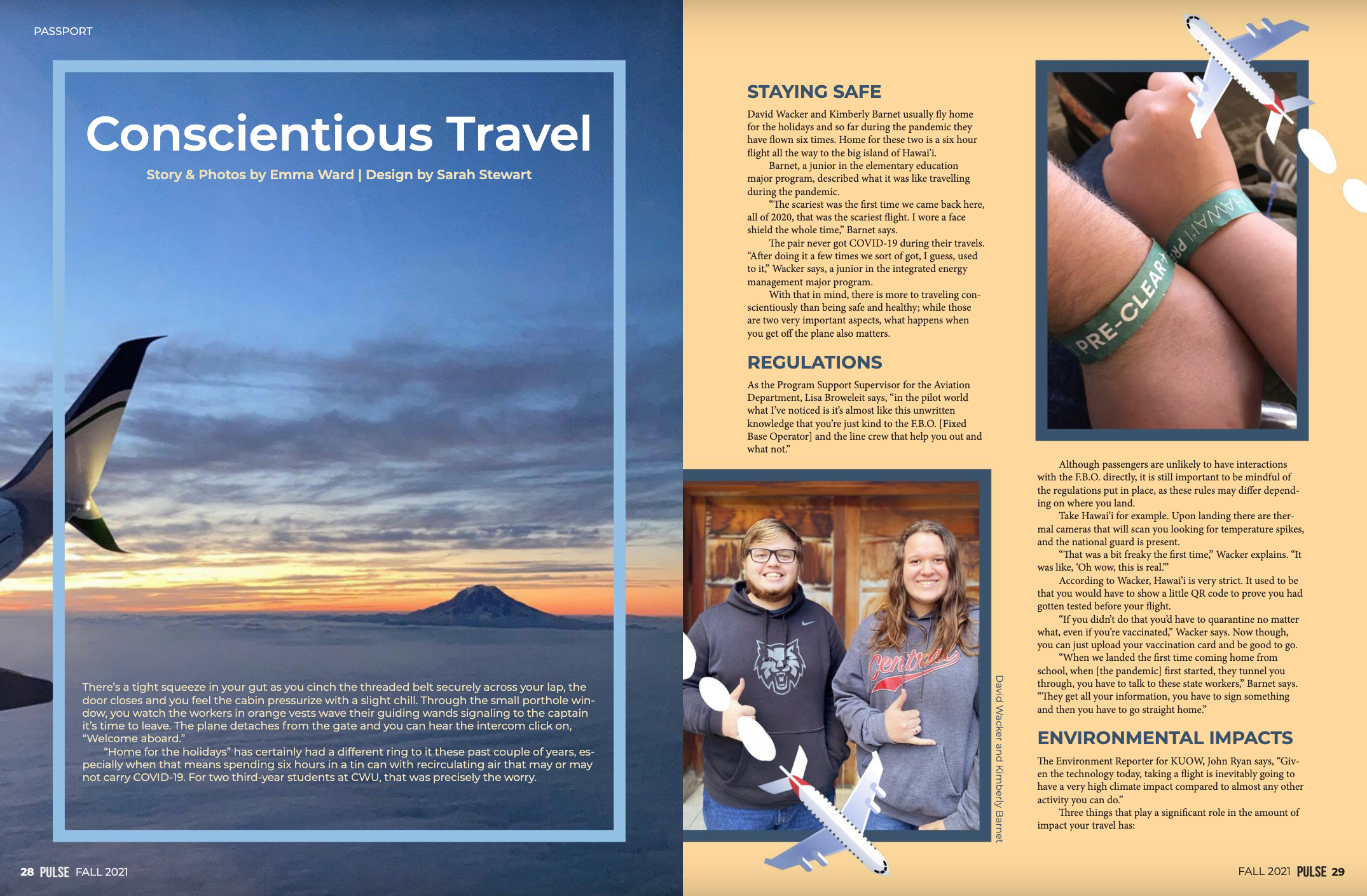Conscientious Travel
Story & Photos by Emma Ward | Design by Sarah Stewart
There’s a tight squeeze in your gut as you cinch the threaded belt securely across your lap, the door closes and you feel the cabin pressurize with a slight chill. Through the small porthole window, you watch the workers in orange vests wave their guiding wands signaling to the captain it’s time to leave. The plane detaches from the gate and you can hear the intercom click on, “Welcome aboard.”
“Home for the holidays”has certainly had a different ring to it these past couple of years, especially when that means spending six hours in a tin can with recirculating air that may or may not carry COVID-19. For two third-year students at CWU, that was precisely the worry.
Staying Safe
David Wacker and Kimberly Barnet usually fly home for the holidays and so far during the pandemic they have flown six times. Home for these two is a six hour flight all the way to the big island of Hawai’i.
Barnet, a junior in the elementary education major program, described what it was like travelling during the pandemic.“The scariest was the first time we came back here, all of 2020, that was the scariest flight. I wore a face shield the whole time,” Barnet says.
The pair never got COVID-19 during their travels. “After doing it a few times we sort of got, I guess, used to it,” Wacker says, a junior in the integrated energy management major program.
With that in mind, there is more to traveling conscientiously than being safe and healthy; while those are two very important aspects, what happens when you get off the plane also matters.
Regulations
As the Program Support Supervisor for the Aviation Department, Lisa Broweleit says, “in the pilot world what I’ve noticed is it’s almost like this unwritten knowledge that you’re just kind to the F.B.O. [Fixed Base Operator] and the line crew that help you out and what not.”
Although passengers are unlikely to have interactions with the F.B.O. directly, it is still important to be mindful of the regulations put in place, as these rules may differ depending on where you land.
Take Hawai’i for example. Upon landing there are thermal cameras that will scan you looking for temperature spikes, and the national guard is present.
“That was a bit freaky the first time,” Wacker explains. “It was like, ‘Oh wow, this is real.’”
According to Wacker, Hawai’i is very strict. It used to be that you would have to show a little QR code to prove you had gotten tested before your flight.
“If you didn’t do that you’d have to quarantine no matter what, even if you’re vaccinated,” Wacker says. Now though, you can just upload your vaccination card and be good to go.
“When we landed the first time coming home from school, when [the pandemic] first started, they tunnel you through, you have to talk to these state workers,” Barnet says. “They get all your information, you have to sign something and then you have to go straight home.”
Environmental Impacts
The Environment Reporter for KUOW, John Ryan says, “Given the technology today, taking a flight is inevitably going to have a very high climate impact compared to almost any other activity you can do.”
Three things that play a significant role in the amount of impact your travel has:
First, there is the number of times you fly. Ryan says that the best thing you can do to help the environment when you travel is not to take a flight, and if you have to take the trip, it’s often better to drive.
Something additional to consider is the distance you travel. A shorter flight will inevitably burn fewer fossil fuels than a trip to the other side of the world.
Finally is the altitude of your flight. If you have a trip that burns a set amount of fossil fuels, the impact from these emissions will be much higher at 31,000 feet than if they are released on the ground.
Is it really better for the environment to drive as opposed to flying?
“It depends on a lot of factors,” he explains. “Like what kind of vehicle you’re riding in, are you taking a private jet? If you’re talking about your average American car and your average economy flight, in most situations it’s going to be better to drive because of the greater impact of exhaust when it's released high in the sky.”
When talking about fossil fuels we are referring to Carbon Dioxide (CO2) as well as other things. Ryan confirms that the CO2 emissions are carefully tracked so the environmental impact is more definitive; however, there are factors that are potentially worse than CO2.
“Scientists have said that they think what they call the non-CO2 impacts of jet exhaust is maybe two times or up to five times bigger than the CO2 itself,” Ryan says. “And those impacts include the water vapor that’s put out along with other particles or particulates in the exhaust.”
Ryan explains that this phenomenon forms contrails of white linear clouds you see in the sky behind many airplanes and those can trap a lot of heat. While the science of how heat is trapped is known, the effects on the climate are still uncertain, he says.
CWU’s aviation program
“Safety is our number one priority,” Broweleit says.
She confirmed all 20 planes are well maintained. The program even has their own maintenance team and five mechanics on staff.
On the subject of COVID-19, Broweleit says things slowed down in the beginning but now the operations include approximately 50 to 60 flight related, ground or otherwise activities per day.
“The biggest difference is instead of going out with just yourself and your flight instructor, you’re also going to go out with some cleaning wipes so you can clean the aircraft and the door handles when you come back,” Broweleit says.
Considering the environment, there’s a greater impact from planes emitting pollutants at a higher altitude and the longer the flights last the more fuel that is burned Broweleit explains. The CWU aviation program allows students to fly as low as 1,500 feet above Ellensburg.
This is significantly lower than the average commercial flight that, according to the Time Magazine website, cruises between 31,000 and 38,000 feet in the air.
Additionally, CWU flights frequently operate in nearby practice areas. According to Broweleit these are referred to as “local flights.”
“Our county is kind of broken into these different practice areas, so that’s what we usually use,” she explains. “Another very common flight is Ellensburg to Yakima and I think another one is to Moses Lake.”
With all of this in mind, if you are looking to get away using alternative travel methods try taking a ferry to the San Juan Islands, hopping on a train down the Washington coastline or going on a road trip with friends.
Alternative Trip Ideas:
It is a 68 minute drive from Ellensburg to Leavenworth
It is a 35 minute ferry ride from Seattle to Bainbridge
It is a 3 hours and 23 minute drive from Ellensburg to Silverwood, Idaho
It is a 3 hour hike to experience Manastash Ridge
It is a 2-3 hour float down the Yakima River if you are feeling like going tubing







